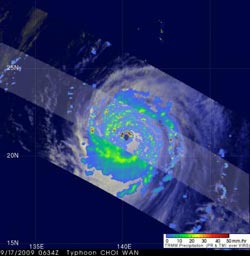NASA's TRMM satellite sees heavy rainfall in Choi-Wan

TRMM captured Super Typhoon Choi-Wan heavy rainfall on Sept. 17 at 2:34 a.m. EDT. The yellow and green areas indicate moderate rainfall between .78 to 1.57 inches per hour. Red areas near Choi-Wan\'s center are considered heavy rainfall at almost 2 inches per hour. Credit: NASA/SSAI, Hal Pierce
TRMM rainfall images are false-colored with yellow, green and red areas, which indicate rainfall between 20 and 40 millimeters (.78 to 1.57 inches) per hour.
Dark red areas are considered heavy rainfall, as much as 2 inches of rain per hour.
Rain rates in the center of the swath are from the TRMM Precipitation Radar (PR), the only spaceborne radar of its kind, while those in the outer portion are from the TRMM Microwave Imager (TMI).
The rain rates are overlaid on infrared (IR) data from the TRMM Visible Infrared Scanner (VIRS).
Media Contact
All latest news from the category: Information Technology
Here you can find a summary of innovations in the fields of information and data processing and up-to-date developments on IT equipment and hardware.
This area covers topics such as IT services, IT architectures, IT management and telecommunications.
Newest articles

Properties of new materials for microchips
… can now be measured well. Reseachers of Delft University of Technology demonstrated measuring performance properties of ultrathin silicon membranes. Making ever smaller and more powerful chips requires new ultrathin…

Floating solar’s potential
… to support sustainable development by addressing climate, water, and energy goals holistically. A new study published this week in Nature Energy raises the potential for floating solar photovoltaics (FPV)…

Skyrmions move at record speeds
… a step towards the computing of the future. An international research team led by scientists from the CNRS1 has discovered that the magnetic nanobubbles2 known as skyrmions can be…





















